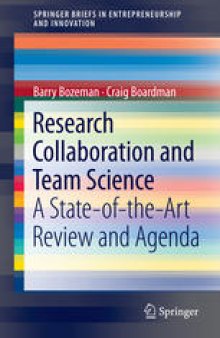 جزییات کتاب
جزییات کتاب
Today in most scientific and technical fields more than 90% of research studies and publications are collaborative, often resulting in high-impact research and development of commercial applications, as reflected in patents. Nowadays in many areas of science, collaboration is not a preference but, literally, a work prerequisite. The purpose of this book is to review and critique the burgeoning scholarship on research collaboration. The authors seek to identify gaps in theory and research and identify the ways in which existing research can be used to improve public policy for collaboration and to improve project-level management of collaborations using Scientific and Technical Human Capital (STHC) theory as a framework.Broadly speaking, STHC is the sum of scientific and technical and social knowledge, skills and resources embodied in a particular individual. It is both human capital endowments, such as formal education and training and social relations and network ties that bind scientists and the users of science together. STHC includes the human capital which is the unique set of resources the individual brings to his or her own work and to collaborative efforts. Generally, human capital models have developed separately from social capital models, but in the practice of science and the career growth of scientists, the two are not easily disentangled.Using a multi-factor model, the book explores various factors affecting collaboration outcomes, with particular attention on institutional factors such as industry-university relations and the rise of large-scale university research centers.
 درباره نویسنده
درباره نویسنده
بری گوردن بوزان (به انگلیسی: Barry Gordon Buzan) (متولد ۲۸ آوریل ۱۹۴۶) استاد بازنشسته روابط بینالملل در دانشگاه اقتصاد لندن و استاد افتخاری در دانشگاه کپنهاگ و دانشگاه جیلین است.وی تا سال ۲۰۱۲ صاحب کرسی مونتاگ برتون در رشته روابط بینالملل در مدرسه اقتصاد لندن بود.



 دانلود کتاب
دانلود کتاب

 جزییات کتاب
جزییات کتاب
 درباره نویسنده
درباره نویسنده





 این کتاب رو مطالعه کردید؟ نظر شما چیست؟
این کتاب رو مطالعه کردید؟ نظر شما چیست؟
